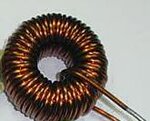AMSA84
Advanced Member level 2
- Joined
- Aug 24, 2010
- Messages
- 577
- Helped
- 8
- Reputation
- 16
- Reaction score
- 8
- Trophy points
- 1,298
- Location
- Iberian Peninsula
- Activity points
- 6,178
Hello there guys.
I'd like to ask if someone has an article, application note or pdf notes where are described the different types and the function of inductors, DC chokes and transformers. I thing that the subject Inductor and DC choke would be more important, since those two are subjects to cause big confusion. At least, for Me.
BTW, I have here some photos (of inductors or chokes - don't know) that perhaps someone can tell if it's a inductor or choke.
1st:

2nd:

3rd:

4th

5th

I've dismounted a power supply from a TFT Monitor, from HP, and there was the choke(?) or inductor(?) like in picture number 4 and in another power supply a choke(?) or inductor(?) like in picture number 1.
I have been told that the 1st one and 4th one are chokes. Is that true? What about the other ones. Besides that, what are the differences between a choke and inductor?
There are too another kind of choke(?) or inductor(?) that looks like a resistor. What they are meant for?
Best regards.
I'd like to ask if someone has an article, application note or pdf notes where are described the different types and the function of inductors, DC chokes and transformers. I thing that the subject Inductor and DC choke would be more important, since those two are subjects to cause big confusion. At least, for Me.
BTW, I have here some photos (of inductors or chokes - don't know) that perhaps someone can tell if it's a inductor or choke.
1st:
2nd:

3rd:

4th

5th

I've dismounted a power supply from a TFT Monitor, from HP, and there was the choke(?) or inductor(?) like in picture number 4 and in another power supply a choke(?) or inductor(?) like in picture number 1.
I have been told that the 1st one and 4th one are chokes. Is that true? What about the other ones. Besides that, what are the differences between a choke and inductor?
There are too another kind of choke(?) or inductor(?) that looks like a resistor. What they are meant for?
Best regards.